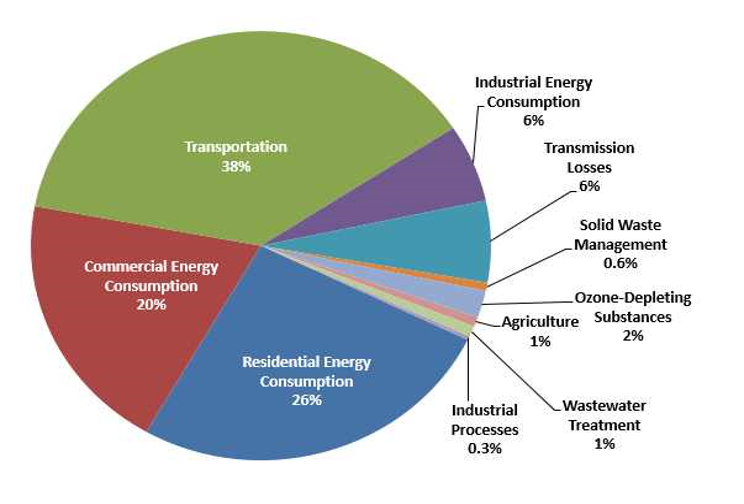Erie County Community Greenhouse Gas Inventory
In the past, the County developed a community GHG inventory, which helped identify key focus areas for the Community Climate Action Plan. The inventory found that transportation, commercial energy consumption, and residential energy consumption are the top three GHG emission sources in Erie County. The County plans to update this inventory in the near future with forthcoming federal grant resources.

Equity as Focus
The legacy of inequity that has been inherited from previous generations is still present today in Erie County, as well as the rest of the country. The compounding issues of past economic policies, such as racially influenced zoning regulations and lending policies, termed “redlining,” have resulted in a segregated County that has areas with deep challenges, including lack of food access, lack of trees, old housing stock, and mobility issues. While many of these problems are most apparent in the urban areas of the County, rural communities also feel the impacts of inequity, poverty, and feeling forgotten.
Erie County has approached this Plan with a commitment to using an equity lens while developing the Plan’s strategies and action items. The working group members used the “Racial Equity Impact Analysis Tool,” which is a series of questions to help ensure that a process does not forget to consider the impact of recommended strategies or actions on minority and disadvantaged communities. More information about this topic can be found in the Climate Justice chapter.
Energy Burden Mapping
High utility burdens can have substantial impacts on the livelihood and health of households in our community. A utility or energy burden represents the percentage of annual income that a household or individual pays toward their utility bills (electricity, natural gas, and/or water). Research has suggested that housing costs should not exceed 30% of household income and in turn, household energy costs should not exceed 20% of these housing costs (6% of total household income).
In addition to households with energy burdens of 6% or greater being considered in “high burden”, those with greater than 10% are considered in “severe burden.”
Energy and water burdens are functions of a number of physical and economic and social factors. Specifically, these burdens are driven by income, the quantity of the utilities consumed and the overall cost of these utility bills. Physical factors such as temperature and other weather patterns play critical roles in influencing the consumption and cost of these utilities.
Through ECLIPSE (Erie County Low Income Program for Sustainable Energy), created to identify specific areas around Erie County that are suffering from energy, electricity, gas, rent and utility burdens. These interactive maps show these burdens in comparison to median income, food deserts and percentage of tree canopy cover per area. Tree canopy cover is important because trees provide shade on high temperature days, create barriers to wind and other weather events and also aids in air quality.

Climate Vulnerability Assessment
In 2020, work began on the Erie County Climate Vulnerability Assessment (CVA). This project is assessing the threat of climate change to our community, the sensitivity of the community to those hazards, and the adaptive capacity of the County government to respond to those threats. The CVA is being conducted in partnership with a research team at the University at Buffalo, and with input from our community stakeholders on the Community Climate Change Task Force.
The first milestone of the CVA is the Erie County Climate Hazards Summary Report, which provides a review of the threat of climate change to our local community, and recommends climate hazards that will be the focus of the CVA project. The Draft Climate Hazards Summary Report, as well as a summary video and survey, are available for public review:
Community Involvement
Erie County Climate Action’ encourages County residents to play an active role in the development of this Plan. Your feedback is necessary to understand how climate change is affecting your community and your family, what you think we should include in the plan to reduce the impact of climate change and create jobs, make your home more comfortable, and make our region more livable.
Climate change affects everyone differently. Your input is important to ensure the plan specifically addresses how it is affecting your neighborhood, your backyard and your family. Even if you only have one minute, you can help can make a difference.
 Community Climate Action Plan
Community Climate Action Plan